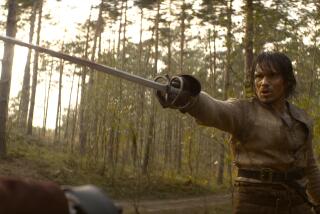Uninhibited, outlandishly funny and oh, so French
“The Triplets of Belleville” delights in the dazzling eccentricity of its uninhibited imagination, and why shouldn’t it? A truly out-there piece of comic animation, the most outlandishly visual film of the year, this 80-minute French treat takes us into a world that can barely be described, a world unlike any we’ve seen before.
Written, directed, story-boarded and graphic-designed by Sylvain Chomet, “Triplets” was as popular as any film at this year’s Cannes Film Festival, even though it was not in competition, causing one French critic to complain in print, “It’s the most inventive, the most droll, the best-directed film and it’s not in competition? Scandale!”
One of the pleasures of “Triplets” is its distinctive -- and distinctively French -- sensibility that is nothing like either the American Disney, the Japanese anime or any other style of animation. It’s closer in spirit to the bande dessinee, the French tradition of visually inventive, book-length, hard-cover comic books that were the writer-director’s first love.
What especially distinguishes Chomet, Oscar-nominated in 1998 for a short called “The Old Lady and the Pigeons,” is the fearlessness of his singular point of view. It’s a trait that includes coming up with a wacky plot involving a kidnapped Tour de France cyclist, an addled and overweight dog, an indomitable clubfooted grandmother and an elderly but still swinging singing group that gives the film its name -- and much, much more.
In an age of cultural timidity, Chomet frankly deals in cliches as well as in caricatures about nationality. His French people dote on frogs for dining pleasure, and the North American residents of Belleville -- an imaginary city that’s in effect Montreal pumped up on Manhattan steroids -- are absolutely gigantic in size, and that includes a hefty Statue of Liberty that’s put away way too many burgers. But all this is done with so much cleverness and so little malice that it’s impossible to do anything but smile.
Too much cleverness can also be a risky thing, but “Belleville’s” unexpected references and zany visuals are equally successful. Whether it’s a maitre d’ so obsequious that he practically becomes a pretzel or a fleet of humble Citroen Deux Chevaux miraculously transformed into stretch limos, these deft touches -- including a coda at the very end of the closing credits -- allow for no resistance.
Another risk “Belleville” takes in this day of super-chatty animation is to be almost completely without dialogue. Not that the film is anything like silent. “Belleville’s” soundtrack is filled with an antic collection of noises (especially those coming from Bruno, that dog of dogs) and a wildly eclectic musical score by Benoit Charest that shifts moods and styles at will.
Language isn’t missed because Chomet’s gift for creating characters that almost magically articulate in body language and facial expression makes dialogue seem superfluous.
“ ‘Animation’ has the word ‘anima’ -- soul -- in it, and for me these are real characters, they exist somewhere,” Chomet said at Cannes. “To bring these drawings to life ... it’s magic, like giving birth.”
“Belleville” opens with one of its cleverest bits, an old newsreel (done in the form of a 1930s Max Fleischer cartoon) that shows the hobble-skirted, fox fur-wearing Triplets in their music-hall prime. Also on the bill are Josephine Baker in a banana skirt, a Django Reinhardt who’s enough of a guitar virtuoso to play with his feet, and a Fred Astaire who’s attacked and destroyed by his suddenly ravenous tap shoes. It’s that kind of an evening.
Watching the newsreel is a sad little boy named Champion and the tiny, no-nonsense, hair-in-a-bun Madame Souza, the grandmother who’s raising him and only wants him to be happy. She tries to give him a dog, then a train (which only scares the dog), but nothing works until she realizes it’s bicycles he loves.
“Triplets” quickly flashes forward to De Gaulle-era France and shows its manic spirit with a wickedly funny sequence on the training routine of Champion, now a world-class cyclist with a nose like the Concorde, calves like cantaloupes and thighs like watermelons. The session ends with Madame Souza massaging him with a vacuum cleaner and an egg beater, and a cameo for the hugely overweight dog, still barking at trains for reasons we eventually see via a wacky glimpse of the animal’s dreams.
Champion is now a Tour de France contestant, but he has trouble with more than the difficult course. He gets kidnapped by sinister, rectangular-shaped members of the French mafia and gets transported across the ocean to Belleville to be used for strange and nefarious purposes. Undaunted -- nothing ever daunts her -- Madame Souza and the overweight dog take a rented paddle boat -- yes, a rented paddle boat -- across the Atlantic, determined, with the eventual aid of those still active singing triplets, to rescue Champion and bring him home.
Fast, funny, unexpected and uninhibited, “The Triplets of Belleville” may be animated, but it is also the product of an artistic vision every bit as rigorous as any lofty Cannes prize-winner. Hearing about a film this special isn’t enough. It demands to be seen, and it generously rewards those who, like Madame Souza, let nothing stand in their way.
*
‘The Triplets of Belleville’
MPAA rating: PG-13, for images involving sensuality, violence and crude humor
Times guidelines: Uninhibited and bawdy animation
Released by Sony Pictures Classics. Director Sylvain Chomet. Producers Didier Brunner, Paul Cadieux. Screenplay Chomet. Editor Chantal Colibert Brunner. Music Benoit Charest. Production design Evgeni Tomov. Running time: 1 hour, 20 minutes.
In limited release
More to Read
Only good movies
Get the Indie Focus newsletter, Mark Olsen's weekly guide to the world of cinema.
You may occasionally receive promotional content from the Los Angeles Times.











